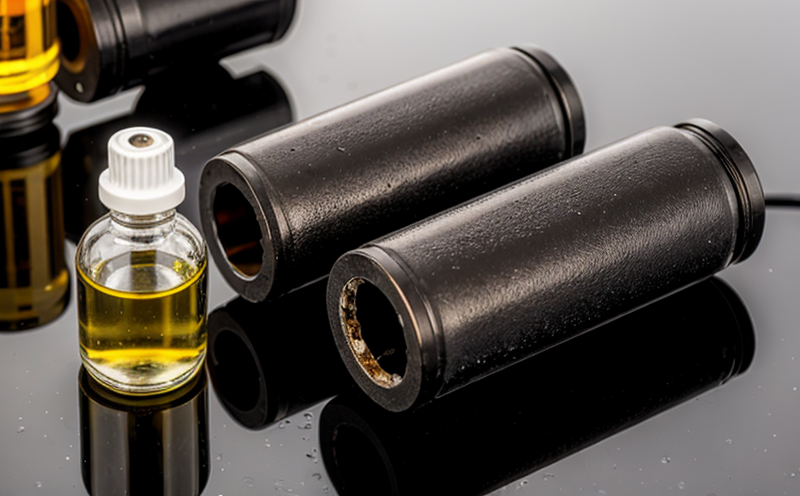ISO 9377 Oil Mineral Hydrocarbons Index Test in Water
The ISO 9377 Oil Mineral Hydrocarbons Index (OMHI) test is a crucial method used to assess the presence and concentration of hydrocarbon contaminants in water samples. This standardized procedure plays an essential role in environmental monitoring, particularly for industries involved in oil exploration, production, transportation, and wastewater management.
Hydrocarbons are compounds composed entirely of hydrogen and carbon atoms, often found in petroleum products. In water bodies, these contaminants can originate from various sources such as accidental spills, industrial discharges, or natural seepage. The OMHI test helps quantify the total oil and grease content in a water sample, which is critical for understanding pollution levels and implementing effective remediation strategies.
The ISO 9377 procedure involves several key steps to ensure accurate results:
- Sample Collection: Proper collection of representative samples from different locations within the water body.
- Preparation: Dilution or concentration of samples as required by the standard, ensuring no contamination during preparation.
- Measurement: Use of infrared spectrophotometry to measure the absorbance at specific wavelengths that correspond to oil and grease components.
- Calculation: Determination of the OMHI value based on the measured absorbance and calibration curve derived from reference standards.
The OMHI is expressed as a percentage, representing the total amount of oil and mineral hydrocarbons present in the water sample. This index provides valuable information for regulatory compliance, environmental impact assessment, and process optimization in industrial settings.
Understanding the OMHI value helps stakeholders make informed decisions regarding the effectiveness of pollution control measures and the potential risks associated with contaminated water sources.
| Application | Description |
|---|---|
| Oil Refineries | Evaluation of wastewater treatment efficiency before discharge into natural water bodies. |
| Petroleum Transportation | Monitoring hydrocarbon content in pipeline effluents to ensure compliance with environmental regulations. |
| Mining Operations | Detection of oil and grease contamination from mining activities affecting nearby water resources. |
| Environmental Impact Assessment | Baseline measurements for assessing the impact of industrial activities on aquatic ecosystems. |
The OMHI test is widely recognized in the environmental sector as a robust method for hydrocarbon analysis. Compliance with ISO 9377 ensures that results are consistent and reliable, facilitating effective decision-making processes across various industries.
Benefits
- Compliance Assurance: Ensures adherence to environmental regulations and standards for oil and grease content in water.
- Accurate Assessment: Provides precise measurement of hydrocarbon contamination levels, aiding in targeted remediation efforts.
- Data Reliability: Standardized testing methods yield consistent results, enhancing trustworthiness within regulatory frameworks.
- Process Optimization: Identification of areas requiring improvement in wastewater treatment processes and industrial operations.
- Risk Management: Early detection of potential environmental hazards through regular monitoring of water quality.
Quality and Reliability Assurance
The ISO 9377 test is designed to meet the highest standards of accuracy and reliability. Rigorous calibration procedures, use of certified reference materials, and adherence to strict laboratory protocols ensure that results are trustworthy and repeatable.
Laboratory staff undergo continuous training to maintain proficiency in performing OMHI tests according to ISO 9377 guidelines. Quality assurance processes include regular internal audits, participation in inter-laboratory comparison studies, and implementation of quality control measures such as method verification and validation.
The use of advanced instrumentation like infrared spectrophotometers guarantees precise measurement of hydrocarbon content. Calibration curves are regularly updated to account for changes in reference standards or analytical methods. By adhering to these stringent procedures, we provide clients with reliable OMHI test results that can be confidently used for regulatory reporting and internal decision-making.
Use Cases and Application Examples
| Application | Description |
|---|---|
| Oil Refineries | Evaluation of wastewater treatment efficiency before discharge into natural water bodies. |
| Petroleum Transportation | Monitoring hydrocarbon content in pipeline effluents to ensure compliance with environmental regulations. |
| Mining Operations | Detection of oil and grease contamination from mining activities affecting nearby water resources. |
| Environmental Impact Assessment | Baseline measurements for assessing the impact of industrial activities on aquatic ecosystems. |
The OMHI test is a vital tool in environmental monitoring, helping industries comply with regulatory requirements while ensuring the protection of water quality. By integrating ISO 9377 into their quality management systems, organizations can achieve greater transparency and accountability in managing hydrocarbon contamination risks.





